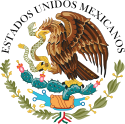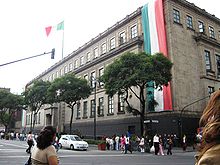- Supreme Court of Justice of the Nation
-
Mexico 
This article is part of the series:
Politics and government of
MexicoExecutive- Congress (current)
- Senate
- Chamber of Deputies
- Supreme Court
- Political parties
- Elections
Judiciary- Supreme Court of Justice of the Nation
- Federal Electoral Tribunal
- Federal Electoral Districts of Mexico
General
Other countries · Atlas
Mexico Portal
The Supreme Court of Justice of the Nation (Spanish: Suprema Corte de Justicia de la Nación (SCJN) is the highest federal court in the United Mexican States. It consists of a President of the Supreme Court (Chief Justice) and ten Ministers (Associate Justices) who are confirmed by the Senate from a list proposed by the President of the Republic.
Justices of the SCJN serve for fifteen years and are not eligible to serve a second term. From among their number, the justices elect the President of the Court to serve a four-year period; a given justice may serve more than one term as president, but not in consecutive periods.
Contents
Supreme Court building
The court itself is located just off the main plaza of Mexico City on the corners of Pino Suarez and Carranza Streets. It was built between 1935 and 1941 by Antonio Muñoz Garcia. Prior to the Conquest, this site was reserved for the ritual known as "Dance of the Flyers" which is still practice today in Papantla. Hernan Cortes claimed the property after the Conquest and its ownership was in dispute during much of the colonial period with Cortes' heirs, the city government and the Royal and Pontifical University all claiming rights. It was also the site of a very large market known as El Volador.[1]
The interior of the building contains four panels painted in 1941 by José Clemente Orozco, two of which are named "The Social Labor Movement" and "National Wealth." There is also one mural done by American artist George Biddle entitled "War and Peace" at the entrance to the library.[1] The building also contains a mural by Rafael Cauduro, which "graphically illustrates the Gran Guignol of Mexican torture",[2] and includes a depiction of the 1968 Tlatelolco massacre as well as "a cut-away of a prison, perhaps the infamous Lecumberri Black Palace where the student leaders who escaped death were jailed."[2]
While this building is still the main home of the Court, an alternative site on Avenida Revolución was established in 2002.[3]
Current composition
Title Name Born Appt. By Senate Conf. vote Age at appt. Elected /
Length of serviceChief Justice Juan N. Silva Meza September 13, 1944
(age 67)
in Mexico CityErnesto Zedillo 50 January 26, 1995
16 years, 9 monthsJustice Sergio Salvador Aguirre Anguiano February 1, 1943
(age 68)
in Guadalajara, JaliscoErnesto Zedillo 51 January 26, 1995
16 years, 9 monthsJustice Olga Sánchez Cordero 1955
in Mexico CityErnesto Zedillo 40 January 26, 1995
16 years, 9 monthsJustice Guillermo Iberio Ortiz Mayagoitia February 10, 1941
(age 70)
in Misantla, VeracruzErnesto Zedillo 53 October 27, 1995
16 yearsJustice José Ramón Cossío Díaz December 26, 1960
(age 50)
in Mexico CityVicente Fox 84 42 December 12, 2003
7 years, 11 monthsJustice Margarita Luna Ramos January 4, 1956
(age 55)
in San Cristóbal de las Casas, ChiapasVicente Fox 83 48 February 19, 2004
7 years, 9 monthsJustice Sergio Armando Valls Hernández May 20, 1941
(age 70)
in Tuxtla Gutiérrez, ChiapasVicente Fox 85 63 March 10, 2004
6 yearsJustice José Fernando Franco González Salas December 4, 1950
(age 60)
in Mexico CityVicente Fox 94 56 December 12, 2006
4 years, 11 monthsJustice Luis María Aguilar Morales November 4, 1949
(age 62)
in Mexico CityFelipe Calderón 91 60 December 1, 2009
1 year, 11 monthsJustice Arturo Zaldívar Lelo de Larrea August 9, 1959
(age 52)
in Querétaro, QuerétaroFelipe Calderón 90 50 December 1, 2009
1 year, 11 monthsJustice Jorge Mario Pardo Rebolledo February 1, 1961
in Xalapa, VeracruzFelipe Calderón 91 50 February 10, 2011
9 monthsChief Justices
The following have held the position of Chief Justice ("Presidente de la Suprema Corte de Justicia de la Nación") under the 1917 Constitution:
- 1917–1919: Enrique M. del Río
- 1919–1920: Ernesto Garza Pérez
- 1920–1922: Enrique Moreno Pérez
- 1922–1923: Gustavo A. Vicencio
- 1923–1924: Francisco Modesto Ramírez
- 1924–1925: Gustavo A. Vicencio
- 1925–1927: Manuel Padilla
- 1927–1928: Francisco Díaz Lombardo
- 1928–1929: Jesús Guzmán Vaca
- 1929–1933: Julio García
- 1934: Francisco H. Ruiz
- 1934–1940: Daniel V. Valencia
- 1941–1951: Salvador Urbina
- 1952: Roque Estrada Reynoso
- 1953: Hilario Medina
- 1954: José María Ortiz Tirado
- 1955–1956: Vicente Santos Guajardo
- 1957: Hilario Medina
- 1958: Agapito Pozo Balbás
- 1959–1964: Alfonso Guzmán Neyra
- 1965–1968: Agapito Pozo Balbás
- 1969–1973: Alfonso Guzmán Neyra
- 1974–1975: Euquerio Guerrero López
- 1976: Mario G. Rebolledo Fernández
- 1977–1981: Agustín Téllez Cruces
- 1982: Mario G. Rebolledo Fernández
- 1982–1985: Jorge Iñárritu y Ramírez de Aguilar
- 1986–1990: Carlos del Río Rodríguez
- 1991–1994: Ulises Schmill Ordóñez
- 1995–1999: José Vicente Aguinaco Alemán
- 1999–2002: Genaro David Góngora Pimentel
- 2002–2006: Mariano Azuela Güitrón
- 2007–2011: Guillermo Ortiz Mayagoitia
- 2011-incumbent: Juan N. Silva Meza
Associate Justices (Minister)
The following have held the position of Associate Justice ("Ministro de la Suprema Corte de Justicia de la Nación") under the 1917 Constitution:
- 1917–1919:
- 1919–1920:
- 1920–1922:
- 1922–1923:
- 1923–1924:
- 1924–1925:
- 1925–1927:
- 1927–1928:
References
- ^ a b Galindo, Carmen; Magdalena Galindo (2002). Mexico City Historic Center. Mexico City: Ediciones Nueva Guia. p. 60. ISBN 968 5437 29 7.
- ^ a b John Ross, CounterPunch, 16 July 2010, In the Basement of Mexican Justice, No One is Innocent
- ^ "¿Qué es la Suprema Corte de Justicia de la Nación y dónde se ubica?" (in Spanish). http://www.scjn.gob.mx/NR/exeres/BADD8530-3CF9-490B-B310-0550E875EB7D,frameless.htm. Retrieved 2009-03-24.[dead link]
External links
- (Spanish) Official site
Landmarks and historic buildings of Mexico City Centro Zócalo
and immediate vicinitySchools and colleges Universidad del Claustro de Sor Juana · Academia Mexicana de la Historia · Academy of San Carlos · Colegio de San Ignacio de Loyola Vizcaínas · Antigua Escuela de Economía · Colegio Nacional · Colegio de Minería
Government buildings Old Customs Building · Chamber of Deputies · Departamento de Estadistica Nacional · Secretariat of Public Education Main Headquarters · Senate building · Supreme Court building · Palace of the Marqués del Apartado · Library of the Congress of Mexico
Religious buildings Nuestra Señora de Loreto Church · Church of San Francisco · Church of Nuestra Señora de Valvanera · Church of San Bernardo · Ex Temple of Corpus Christi · La Enseñanza Church · La Merced Cloister · La Santisima Church · Temple and Ex-convent of Jesus Maria · Church of San Juan de Dios · Santa VeraCruz Church · Regina Coeli Church · Santa Teresa la Antigua · Temple of San Pablo el Nuevo · Church of Santo Domingo · Temple of Saint Augustine · Temple of San Felipe Neri "La Profesa" · Church of La Soledad
Museums San Ildefonso College · Caricature Museum · Franz Mayer Museum · Museum of the City of Mexico · Interactive Museum of Economics · Museo de Arte Popular · José Luis Cuevas Museum · Palace of the Inquisition (Museum of Mexican Medicine) · Mexican Army Museum · Museo Nacional de Arte · Museo de Charrería · Museo de la Estampa · Museo de Estanquillo · Museum Archive of Photography · Museum of Secretaría de Hacienda y Crédito Público · San Pedro y San Pablo College (Museum of Light) · House of the First Print Shop in the Americas · National Museum of Cultures · Borda House, Mexico City
Palaces Castillo de Chapultepec · Palace of Iturbide · Palacio de Bellas Artes · Palacio de Correos de Mexico · Casa de los Azulejos · Houses of the Mayorazgo de Guerrero · Palace of the Marqués del Apartado · Palacio de la Autónomia
Historic houses Tlaxcala House · House of Count de la Torre de Cossio · House of the Marquis of Uluapa · House of the Count de la Torre Cosío y la Cortina
Other Plaza Garibaldi · Antigua Escuela de Jurisprudencia · Chinatown (Barrio Chino) · Tlaxcala House · Garden of the Triple Alliance · Centro Cultural de España (Mexico City) · INAH Building · Abelardo L. Rodriguez Market · La Merced Market · Lirico Theatre · Alameda Park · Plaza Santo Domingo · Teatro Hidalgo · Teatro de la Ciudad · Torre Latinoamericana · Hospital de Jesús Nazareno · Tlaxcoaque
Supreme Courts of North America Sovereign states - Antigua and Barbuda
- Bahamas
- Barbados
- Belize
- Canada
- Costa Rica
- Cuba
- Dominica
- Dominican Republic
- El Salvador
- Grenada
- Guatemala
- Haiti
- Honduras
- Jamaica
- Mexico
- Nicaragua
- Panama
- Saint Kitts and Nevis
- Saint Lucia
- Saint Vincent and the Grenadines
- Trinidad and Tobago
- United States
Coordinates: 19°25′52.01″N 99°7′55.58″W / 19.4311139°N 99.1321056°W
Categories:- Mexican Judicial Branch of Government
- National supreme courts
- Mexican Supreme Court justices
- Landmarks in Mexico City
- Buildings and structures in Mexico City
- Government agencies established in 1917
- Official document archives
- 20th century in Mexico
- Mexican architecture
- 1930s architecture
- Mexican art
- Congress (current)
Wikimedia Foundation. 2010.

